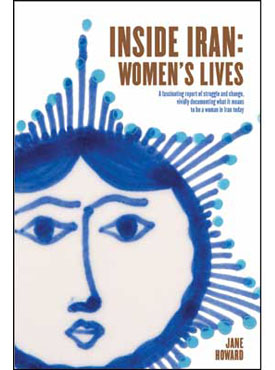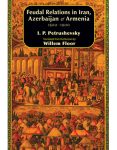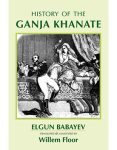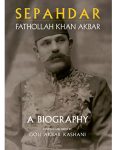About the Book
TV crews and foreign correspondents come and go, but former BBC correspondent Jane Howard made her home in Iran for five years, raising her two young children there. Her experience took her beyond the headlines and horror stories and into the lives of everyday Iranian women. Her brilliantly observed report, Inside Iran: Women’s Lives, takes the reader from dinner in a presidential palace to tea in a nomad’s tent. From women working in rice paddies and tea plantations to highly educated women in Tehran who have been banned from working in their professions. The image of Iranian women is still one of anonymous ranks of revolutionary marchers, clad in black. But underneath their black chadors or drab raincoats, they not only wear jeans, T-shirts and Lycra leggings, but they also work outside the home, drive, play sports and even become politicians. While many women haven’t regained the Western-style freedom they lost in the revolution of 1979, others have won rights they never had before. Practically every girl has access to primary education now, and even remote villages have clean drinking water, a paved road and a school. Yet Islamic law continues to impose many inequities and constraints. In cash terms, for example, a woman’s life is worth half that of a man’s, and in the courtroom, two women have to give evidence to equal one man’s testimony. Howard describes how the atmosphere changed with the election of the reformist president Khatami, and Iranians dared to demand more freedom and discuss their problems openly. She has interviewed government officials and opinion formers, and has traveled throughout the country to meet with women from all sectors of society. The result is a fascinating story of struggle and change, vividly documenting what it means to be a woman in Iran.
Reviews
“Howard places in context the history and politics of gender in Iran, making this volume accessible to a popular audience.”
– – Library Journal /July 2002
“…Very much worth reading. The personal stories Howard presents are moving and colorful, and they enable us to understand Iranian women more fully than cold statistics would allow.”
– – New York Times Book Review / September 2002
Excerpt
Chapter 1 – All the President’s Women
I was invited to dinner with the wife of the president of Iran, and I was wondering what to wear. It was December 1997 and I was living in Tehran, where my husband was posted with the UN. The wives and daughters of the ruling elite would be there, as well as the relatives of the late Ayatollah Khomeini, leader of the 1979 revolution. These are women whom the outside world has only seen veiled in black, with a triangle for a face. These shadowy figures are at the heart of Iran’s Islamic regime, held up as models of womanhood, yet for the most part, anonymous and hidden. I wondered, not for the first time, what these women wore under their chadors, the black sheets that cover the most traditional and Islamic Iranian women. I also wondered how they felt about the revolution two decades ago, which ordered women to cover up, shun the West and devote themselves to their homes.
As I fingered the invitation, decorated with an intricate floral border, I thought that perhaps I should finally invest in a chador. But this was to be a women-only dinner, so I knew that it would be exempt from hejab, the strict rules of covering up under Islamic law. I couldn’t imagine arriving clutching a chador with one hand or with gritted teeth, like the women I saw struggling back from the bazaar with their hands full of shopping bags and squirming toddlers. I knew I didn’t really need a chador. Living in northern Tehran, most foreigners and many Iranians conform to the law with a long coat and headscarf. Since moving to Iran, I had accumulated four of the unlined overcoats known as manteaus or rupushes. I had bought them in different colors, in a vain quest for a garment that would feel cool and light in 105¡F heat. But in the end, like everyone else, I often wore black. It seemed easier not to stand out in the crowd.
I put on black velvet trousers and a silk shirt and covered up with a long thin black coat with large gilt buttons and padded shoulders. I was careful not to wear open-toed sandals (considered immodest) and made sure I had black socks on. It is not unusual to be stopped in the street and berated for wearing see-through stockings, or, worse still, none at all. These days, foreigners who break the law — euphemistically known as “the Islamic Dress Code” — usually get away with a scolding, but Iranian women, especially young ones, can be interrogated for hours or even days at special centers for “the Prevention of Vice and Enjoining of Virtue.” Some two decades after the revolution, women still live in fear of a flogging for showing more than a couple of inches of hair in violation of religious tradition and the “Islamic Penal Code.” The sentence has been gradually reduced and now generally entails a fine, but the fear remains.
I set off for the dinner with Evelien von der Schulenburg, wife of the most senior UN official in Iran. We drove to one of the Shah’s former palaces in a leafy area at the foot of the mountains, where the deposed ruler used to entertain in grand style. Big gates opened and we swept into an imposing 1950s-style building set in a large park. We walked up the steps, then pushed our way through a curtain hanging inside the entrance to frustrate male curiosity (the word hejab originally meant “curtain” in Arabic). Inside was a row of female Foreign Ministry officials, surprisingly difficult to recognize without their usual strict Islamic dress. They urged us to take off our scarves and coats.
Then we were taken through to meet our hostess, Zohreh Sadeghi, the wife of President Khatami (like all Iranian women, she uses her own name) and her two daughters, Leila and Narges. Dressed in a dark suit, she welcomed us warmly but shyly. The daughters, smart and poised, spoke more English. Most of the guests seemed to have dressed as if for a smart lunch.
We were ushered into a large anteroom furnished around the edges with the formal, French-style gilt furniture loved by Iranians. We sat and nibbled pistachio nuts, dates, dried fruit and sweetmeats, and watched the other guests arrive. The dinner was being held in honor of dignitaries present at the summit of the Organization of the Islamic Conference.
More than fifty heads of state and their spouses were at the conference. The wife of the prime minister of Malaysia, Dr. Siti Hasmah Mohamed Ali, looked exotic in vivid oriental silk. The wife of the UN Secretary-General, Nane Annan, looked sophisticated in black. The ambassador of Sierra Leone, Alari Cole, the only female diplomat to head a mission in Tehran, appeared in a brightly colored national dress. Not everyone looked as stunning. One Iranian wore a synthetic-looking suit with a peach-colored jacket and a black skirt. Strange matching handkerchiefs dangled down around her hips from the hem of her top. As she walked, I noticed that her black stockings were not tights but knee-highs. One had slipped and was exposing her leg. Several women did not take off their headscarves.
“Where in the world is she from,” I said to Evelien, suddenly. We both gasped at her grand entrance. She was tall, leggy, with dyed blonde hair. She was wearing a long, black velvet gown covered in sequins and split up to the thigh. She walked confidently across the room, straight up to us and introduced herself. “Hello, I’m Faezeh Hashemi,” she said. The daughter of the former president Rafsanjani, and one of the most famous women in Iran, hers was the most daring outfit of the evening.
“Do you mind if I touch it,” laughed Evelien, leaning over to feel the texture of the dress.
Looking rather distracted, and having some difficulty with English, Faezeh, as she is known, brightened when I asked her how preparations were going for the Islamic Countries’ Women’s Games, due to start just after the summit ended. She offered to send us an invitation to the opening ceremony. I was unable to attend but later heard how colorful figures on Rollerblades whizzed round the arena at top speed, reenacting an Iranian legend about a woman warrior. After distinguishing herself in battle, the fighter is revealed to be a woman when her hair falls down.1 The skaters, in fact, were men. “They couldn’t have women letting their hair down,” Faezeh told me later, “so they had to put wigs on the male skaters.”
When the dinner was served, waitresses in strict navy-blue uniforms brought out endless qualities of food. The lavish seven or eight course meal included Iranian caviar, chicken in walnut and pomegranate sauce, chicken with tangy red zereshk (barberries), and the ubiquitous kabab. But it was disappointingly bland compared to the sophisticated home cooking I had already encountered in Iranian homes.
Faezeh Hashemi did not stay long at the dinner. She was too busy with her latest project. She’s passionate about sports, politics and a host of other causes. Women’s sports were almost banned after the revolution, when mullahs suggested that it was more appropriate for women to keep fit in their own homes, away from prying eyes. But Faezeh has used her connections to campaign for better sports facilities for women and their right to compete in the international arena. She was rumored to have won the biggest number of votes of any single candidate in the 1996 parliamentary elections although officially she came in second. However, four years later she failed to win re-election, losing her parliamentary seat when the popularity of her father waned. She sees herself as a champion of women’s rights, publicly defending the right of women to wear blue jeans and sneakers underneath the veil. Some months after our first meeting, she launched into publishing and started up a newspaper, Zan, or “Woman.” It did not set out to cover women’s issues alone, but also to provide support to the relatively liberal government of President Khatami, who was elected in a landslide in 1997. Zan did not survive for long.It was closed down in a vicious power struggle between a growing band of reformers and conservatives who saw themselves as guardians of the revolution and defenders of Islam.
Faezeh’s mother — a solid-looking, warm, lively woman — was also at the dinner. As a family, they seemed an unconventional. Her sister, Fatemeh, was also there, dressed in a smart, scarlet suit. She has also been active in defending women’s rights, within Islamic limits. In the 1990s, Fatemeh headed an office in the Foreign Ministry set up to try to improve the image of Iranian women abroad. Outsiders are surprised to find that Iran sees itself as a defender of women’s rights. It tries to distance itself from ultra-conservative regimes such as the one in Saudi Arabia or the one then in power in neighboring Afghanistan. In both these countries, women have had to contend with being banned from working or driving, let alone entering politics. Fatemeh complained to me later that Western observers blamed Islam for a host of iniquities, which could mostly be laid at the door of tradition. “In Islamic countries, people’s customs, traditions and superstitions are mixed up with Islamic laws, and the result you are presented with is not just Islam,” she said. “We believe that if you could follow pure Islam, it could meet the needs and aspirations of women in the whole world.”
This is the Islamic feminist point of view, which states that Islam affords all the protection a woman is likely to need. While Fatemeh agreed that women’s rights in Iran have room for improvement, she found no difficulty with the statute that permits a girl to be married at the age of nine whereas a boy must wait until fifteen. “I personally think a difference of five to six years is appropriate because girls mature earlier, become wiser, earlier than boys, even in physical terms,” she said. “Girls grow up sooner.” She and her sister also defended the system of arranged or “assisted” marriages, where the parents choose marriage partners for their children. Fatemeh and Faezeh married two brothers from the same family. The matchmaking took place in unusual surroundings: “My husband’s father and my father were in the same cell in jail together and that was the grounds for their acquaintance,” she said.2 “In Iran, the tradition is different from what happens in the West. In fact, I was courted.” None of the women at the party saw any contradiction between their belief in tradition and their right to work and take part in public life. The fact that they were not covered up, presenting the strictly anonymous official image, did not make them any less of a puzzle to me. The evening intensified my desire to find out more about the lives of other women in Iran.
* * *
To most outsiders, Iran remains a mystery. It is Middle Eastern, but not Arab. It has a grim, dark image of revolution and terror, yet travelers report warm, hospitable people who love to meet foreigners. Women cannot travel abroad without their husband’s permission, yet more girls than boys go to university. Iran defies description, and visiting journalists, even the most committed, tend to find what they expect to find and seek no further. Few of them travel outside the big cities of Tehran, Isfahan and Shiraz, and few grasp the geographical complexities and vastness of the country.
Iran is cut off from its neighbors by the Caspian Sea and the Persian Gulf to the north and south, and by ranges of mountains and deserts to the east and west. Yet it has always served as an important trading route. This applies equally to the days of the Silk Road and to the time of the Great Game in the nineteenth century, when Britain and Russia vied with each other over control of Iran and access to the Persian Gulf, Afghanistan and India. Living in Tehran, in the high plateau in the middle, it is easy to enjoy a pleasant, dry climate in spite of chronic pollution and twelve million inhabitants. Although on the edge of a great salt desert, Tehran is always green and fresh, with plenty of surface water coursing down from the melting snow of the Alborz Mountains. I learned to ski (suitably covered, with long coat flapping) at a resort only an hour’s drive to the north, whereas to the south you can put an off-road vehicle through its paces on sand dunes and dried out riverbeds.
Iran’s population of more than sixty million is now mostly concentrated in cities. The migration from villages to towns is probably the most significant feature of twentieth century life and is undoubtedly where the roots of the revolution lie. Yet many still live a traditional, rural life and more than a million Iranians describe themselves as nomads. They live in tents, and move from pasture to pasture in isolated mountain areas. In spite of repeated attempts to get them to settle, they continue to eke out a living rearing sheep and goats. Women of the various tribes produce some of the world’s most sought-after carpets and handicrafts. Forced to settle, they miss the independence and status of the traditional life. I was shocked to hear of some of the problems of suicide and depression they encounter.
The sheer size of the country is difficult to convey. A Travel Guide to Iran points out that from one corner of Iran to the other is approximately the same as the distance from Paris to Athens. A visit to Baluchestan, on the border with Pakistan and Afghanistan, gave me an idea of the scale of things. The flight from Tehran, much of it over completely empty desert and scrub, took around two hours. The bus journey would take nearer to twenty-two. From the regional capital to Mount Taftan, a smoldering volcano on the border where I visited a cluster of villages, there were few signs of human habitation on the road. No wonder girls still have difficulty traveling to school in this region. Yet in the north, the Caspian Sea provinces are densely populated and highly cultivated. Women work in water up to their knees in flooded rice paddies and pick tea in plantations of emerald-green bushes. The green of the north is startling, indeed some areas of jangal, or mountain forest, have subtropical flora all of their own.
The central desert area, the Dasht-e Kavir, is disappointingly empty apart from spectacular dried up salt lakes. But at regular intervals there are impressive remains of old caravanserais, fortified staging posts built along the ancient Silk Road. The towns around the edge of the desert, such as Yazd, Kerman and Kashan, are highly sophisticated commercial and cultural centers. Cities such as Isfahan and Shiraz are the most popular tourist destinations nowadays, with their stunning mosques, decorated palaces and beautiful gardens dating back to the glittering Safavid dynasty of the sixteenth to eighteenth centuries.
To the west are the borders with Iraq, Turkey, Armenia and Azerbaijan. When I arrived in Tehran, I found I could make myself understood at the local grocer’s shop by recalling a few words of Turkish. Around a quarter of Iran’s population speak Turkish, not just in the western provinces, but also in the cities. The western Zagros Mountains are home to the Kurds, who have their own language and, unlike the vast majority of Iranians, are Sunni, not Shiite Muslims.
The south is another country again, or several countries. Around the southern port of Bandar Abbas, you see many dark faces, and you may hear music with African rhythms, a legacy of trade with Zanzibar. Some women wear a borqa, a rigid face mask with a slit for the eyes, more common on the other, Arab, side of the Gulf.3 Near the border with Iraq, a large number of villages are Arabic speaking and bear the scars of the long Iran-Iraq war. Saddam Hussein invaded in 1980 in an attempt to take control of the Iranian oil fields of Khuzestan. The conflict ground on for eight years with massive loss of life estimated at up to one million dead. The war undoubtedly allowed the leaders of the 1979 revolution to consolidate their hold on power as the people accepted all kinds of emergency measures and privations as being in the national interest. Talking to some Iranians who remember that period as if it were yesterday, it sometimes feels as if the war had an equal or even greater impact on them than the revolution itself. In one house near the southwestern city of Ahwaz, an empty ammunition box was still being used for storage. Many homes display photos of young men lost in the fighting. And when I interviewed residents of this area as part of an oral English exam, they told me anecdotes about bombs dropping and palm trees burning. About the revolution they had much less to say, although this may have been due to natural caution.
A striking ethnic mix mirrors Iran’s geographical diversity. Turks, Arabs, Kurds, Armenians live alongside nomadic groups such as the Bakhtiari, Qashqa’i, Lurs and Turkmen — each with distinct ethnic origins. There are so many different languages that when children begin school, only a minority of them have Persian, also known as Farsi, as their mother tongue. When a Ministry of Education official explained this to me, I asked her to repeat it more slowly — I could scarcely believe it.
Not surprisingly, one of the key unifying factors is religion. Iran remains an overwhelmingly Islamic country, with various religious minorities, such as the Christian Armenians, Jews and the Zoroastrians, who follow an ancient, pre-Islamic faith. Some are officially recognized, and tolerated, but other faiths exist underground. Having worked as a BBC correspondent in neighboring Turkey, where religion is kept carefully out of government, I always found it fascinating to observe the differences. Compared to Turkey, Iran has comparatively few mosques or outward signs of mass worship. If Martians landed tomorrow in both countries, there might be some confusion about which state was the post-revolutionary theocracy. There are far more signs of mosque-building in solidly secular, but Sunni, Turkey than in Iran, where Shiism makes religion a more personal affair. Following the death of the Prophet, Mohammad, the Shiites backed Mohammad’s cousin and son-in-law, Ali, in the battle for succession. Iran was converted to Shiism in the sixteenth century, when the rulers of the time saw it as a way of rallying the population against the all-powerful Ottoman Empire, dominated by Sunni Turks. It was also a way of unifying the widely differing ethnic groups, ranging from Baluchis in the east to Kurds in the west, which make up the Iranian nation. Culturally, there are some distinctive differences in the Shiite tradition. There is much emphasis on political opposition, and on the rituals of martyrdom and suffering, commemorating the deaths of Ali and his son, Hossein.
The great variety of ethnic origins and different lifestyles make it a hopeless task to try to describe a typical day in the life of an Iranian woman. Many highly religious women stay at home, cover themselves carefully and center their lives on their children and husbands. Yet others from the same traditional backgrounds go to work, leaving their children with relatives or putting them in the office daycare. Some told me they would die of boredom staying at home. Others lead lives a Westerner could identify with. If they have the means, they shop in supermarkets, own two cars, take holidays abroad and wear international brand-name clothes. Most people’s social lives revolve around their family, yet in the big cities, youngsters go to parties and cafŽs to socialize. One young friend who had just finished film school in the United States told me she went to far more parties in Tehran than she ever had in California.
While the revolution changed many lives, throwing women (and men) out of their jobs and forcing whole families to flee into exile, for others it barely changed things. Village life continues much as it always has, dominated by the sheer hard work of making a living. Erika Friedl’s book, Women of Deh Koh, documents the minutiae of everyday life in a hill village in Iran. Friedl, an anthropologist with a wonderful eye for detail, has been going back to the same community for years. Yet the revolution plays a small part in her narrative. One historian working on a social history of Iran told me that the paucity of documentation never bothered him, as in general, people’s lives changed very little even over centuries.
The big change for women occurred in the nineteenth and early- twentieth centuries, when women began to take part in public life. Contact with the West became more frequent, and shahs were embarrassed by criticism that they kept their women secluded and uneducated. Girls’ schools were opened, in spite of opposition from the clerical establishment. The suffragette movement was widely admired, and women began to organize themselves. The defining moment came in 1936, when Reza Shah, wanting his country to appear more modern, decreed that all women should take off the veil or be punished. His son, the last shah of Iran, granted women the vote in 1963 for similar reasons, pushing forward a series of reforms against the wishes of the clergy.
The 1960s and 1970s passed in a rush toward modernization fuelled by the oil boom and supported by Western governments, notably the United States. Iran is a rich country — at least in natural resources. It is the second-largest oil exporter in opec and has the world’s second-largest known reserves of natural gas. While living standards improved, most of the people migrating to the cities did not feel as if they were sharing in the spoils. They saw conspicuous consumption among the ruling elite and felt increasingly alienated. Nor did they have a voice, for the Shah ruthlessly suppressed dissent, banning political parties and quelling opposition from religious quarters.
For most of this time, Ayatollah Khomeini was in exile, in Iraq and in France. He became the focus of the opposition to the Shah, supported by religious and nonreligious factions alike. His stern face still looks down from posters and murals all over the country. Institutes and committees work hard to keep his memory alive, and several are run by his relatives, including various women. Khomeini’s family and the inner wheel of senior clergy have become the new elite. They remain, however, a closed circle, closed to Iranians, let alone foreigners. The grand dinner party for the Islamic Conference was a unique opportunity for me to meet senior women of the regime in unusual circumstances — without the barrier of the chador.
Khomeini’s daughter, granddaughter and daughter-in-law were guests of honor. The daughter who was present was a philosophy professor and head of the official Iranian Women’s Society. The daughter-in-law, with striking, patrician features and hair pulled back like a dancer, was head of a research center devoted entirely to Khomeini’s life and thoughts. The granddaughter, Zahra Eshraghi, just happened to have married President Khatami’s younger brother. This reinforced the sense of a political dynasty arising out of a tight-knit clergy class.
I met Eshraghi later in her office in the Ministry of Interior, an imposing, modern building with the atmosphere of a large police station, and she shared some memories of her grandfather. She remembered visiting him in exile in Iraq. “I went to see him twice, once when I was four and once when I was ten. The second time was not a very good memory, to be honest,” she said. “I was wearing an Iraqi aba, that’s a white veil that is more open than an Iranian chador, and he took one look at me and told me to wear a proper headscarf, saying, ÔThey might grab you and run off.'” I looked at her strangely and said it must have been a joke. But she said not. She thought perhaps he believed she might be kidnapped for her unusual looks — lighter than average hair and green eyes. She met him again later in the Parisian suburb of Neauphle-le-Chateau where he plotted the downfall of the Shah. He would not allow her to accompany him on the plane for his triumphal return to Iran, for fear it would be shot down by the Shah’s forces. Mostly, she stressed his kindness and fairness, and her memories of him in his role as grandfather.
Of all the “regime women” I met Eshraghi was the only one to deliberately take off her chador in my presence, something I found all the more surprising given the surroundings. She kept on a headscarf but revealed an expensive-looking tailored jacket underneath. She and an English-speaking friend appeared to be wearing light makeup. Their main accessories were cellular phones. Eshraghi presented an equally modern face some years later, giving interviews to visiting journalists covering elections in the late 1990s, when her husband headed a new reformist party.
The more religious women I met, the more I realized that the Iranian clergy class has changed with the times. Ayatollah Khomeini married a thirteen-year-old girl who stayed at home and kept house. He would not let his daughter go to school, although he allowed her to be educated at home. For his granddaughter, it was different, however, even though she was brought up in the conservative religious city of Qom. “My father encouraged us, although it was taboo in Qom at that time for girls to continue with secondary education. Not only did he encourage us, he wanted my sister and myself to go to a special school in Isfahan, which was like a fast track to university. But I was only fifteen at the time and it would have meant boarding school, and I didn’t want to leave my family.”
For an ayatollah to allow his teenage daughter to go away to school was clearly out of the ordinary. During the 1960s and 1970s, education took on increasing importance among the clergy class but also in the population at large. The revolution gave it high priority, and the long-lasting social impact of education is only now beginning to be felt. Far from keeping women at home and in ignorance, the revolution has succeeded in getting many more girls into school. The emphasis on segregated education and compulsory Islamic dress, which outside Iran symbolizes women’s oppression, has enabled many girls from conservative families to go to school for the first time. And one of the most delicious ironies of recent Iranian history is that newly educated women have used their votes to redirect the course of the Islamic revolution.
Even in 1979, women played an important part in deposing the Shah. They took part in mass demonstrations forcing him to leave. When Khomeini took power, it seemed unthinkable that he would abolish their right to vote. He stopped short of that but was personally responsible for imposing religious dress regulations, with the support of religious women activists. One of these activists was Mrs. Amiri, a government official who was helping organize the same Islamic Conference, who told me proudly how she was the first woman in the foreign ministry to adopt Islamic dress, just after the revolution. “Oh my goodness — the reaction there was among my colleagues. When they heard there was a woman wearing hejab and even chador in the Deputy Minister’s office, every day a group of people would come to my office to say hello, just to look at me.” She met with a lot of resistance from other civil servants, but within a few months it became law for all women working in government offices to cover up or lose their jobs. “They had to accept it or go,” she said.
I had always been rather in awe of Mrs. Amiri. She was always extremely helpful to me in my UN job, during the period of the conference and afterwards, when I told her I was planning to write a book. A sweet manner was well hidden under one of the most severe hejabs I had ever seen. Her black coat was covered with a black hood or maqna’eh, like a nun’s wimple, so tightly wrapped around her jaw it surprised me she could talk. (Of course, her chador never slipped.) I asked if the chador was important to her. “Not in itself — my sisters don’t wear it, for example,” she said. “But when I’m working it’s simpler. If I wore a manteau I’d have to go to the bazaar and buy different colors and different scarves.” Her answer was an example of the striking pragmatism for which Iranians are famous.
At the same time it came as no surprise at all to find she still described herself as a “revolutionary woman.” Prior to the revolution, Amiri studied psychology in the U.S., where her husband was also a student. She read writers, fashionable at the time, who popularized a heady cocktail of left-wing ideology and Islam. Among them were Ali Shariati and Ayatollah Motahhari, prominent intellectuals who rejected the Western view of the “modern woman” and conjured up a vision of a “new Muslim woman.” This is the image Iran attempts to present to the West.
The guest I sat next to at dinner, who was married to a deputy foreign minister, put yet another slant on why some women covered their heads even at an all-female gathering. I asked her if they were ultraconservative or very religious. “It’s not because they are very religious that they’re wearing it,” she laughed. “It’s more that they don’t have the proper clothes or hairdo to appear in public,” she said. Maryam Imanieh had also studied abroad with her husband, in California. She asked me if I’d seen the pictures of that year’s Army Day, when phalanxes of women volunteers marched past carrying automatic rifles. “It gives such a wrong image,” she laughed. “I’m a practicing Muslim and I’m happy with my hejab, but I’m just like women in other countries.” She worked as Director of International Affairs at the Institute for Iranian Contemporary History, and I met her again later in her own office. Her newly created post seemed to be aimed at opening up the institute to the rest of the world. In Iran, contact with the West was still often referred to with hostility as “cultural invasion.” Yet the Khatami presidency was opening up the floodgates to the modern world. The institute had just set up its own Website to enable worldwide computer communication. “We went on the Internet two months ago,” she said. “In the first month the response was about 180,000 Ôhits,’ as they call it. If you don’t become part of it, you’re really missing out.”
The conversation turned to the problem of malnutrition in Iran, which affects almost one in five children under five, and, in some areas, girls more than boys. Imanieh had visited homes in a deprived area of Denver as part of a university degree in nutrition: “It was unbelievable that in such a city you could see such poor people. The kids were chubby, but you could see signs of malnutrition in their eyes.”
At this point the sound of the midday call to prayer threatened to drown us out. Imanieh got up and shut the window — Islam sat lightly on her shoulders. There was none of the dour fanaticism or sanctimonious show I had encountered routinely in other officials. I told my husband how much I had liked her. “Is she someone you could get to know socially?” he asked. As I hesitated to reply, I realized that the women of the revolutionary establishment remain a closed society. They have benefited tremendously from their connections, their closeness to the new center of power, and they have had a substantial impact on the situation of women since the revolution. But they remain a class apart — theirs is the official face of women in Iran.
About the Author
Jane Howard is a freelance journalist living in Geneva. A graduate of Cambridge University, she worked as a foreign correspondent for BBC World Service and The Guardian, reporting from Turkey, Yugoslavia and Eastern Europe. She covered the fall of Communism in Bulgaria and the war in Croatia and Bosnia. From the beginning of 1996 to the end of 2000, she lived in Iran where her husband was working for the United Nations. She has two sons.








